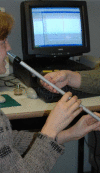Diagnostic tools in Rhinology EAACI position paper
- PMID: 22410181
- PMCID: PMC3294630
- DOI: 10.1186/2045-7022-1-2
Diagnostic tools in Rhinology EAACI position paper
Abstract
This EAACI Task Force document aims at providing the readers with a comprehensive and complete overview of the currently available tools for diagnosis of nasal and sino-nasal disease. We have tried to logically order the different important issues related to history taking, clinical examination and additional investigative tools for evaluation of the severity of sinonasal disease into a consensus document. A panel of European experts in the field of Rhinology has contributed to this consensus document on Diagnostic Tools in Rhinology.
Figures


















References
-
- Bousquet J, Khaltaev N, Cruz AA, Denburg J, Fokkens WJ, Togias A. et al.Allergic Rhinitis and its Impact on Asthma (ARIA) 2008 update (in collaboration with the World Health Organization, GA(2)LEN and AllerGen) Allergy. 2008;63(Suppl 86):8–160. - PubMed
-
- Fokkens W, Lund V, Mullol J. European position paper on rhinosinusitis and nasal polyps 2007. Rhinol Suppl. 2007. pp. 1–136. - PubMed
-
- Bousquet J, Van Cauwenberge P, Khaltaev N. Allergic rhinitis and its impact on asthma. J Allergy Clin Immunol. 2001;108(5 Suppl):S147–334. - PubMed
LinkOut - more resources
Full Text Sources
Other Literature Sources

